This easy Vegan Paella is an authentic Spanish recipe, full of rich flavors and a crispy golden crust. A perfect dish that’s hearty, delicious, and entirely plant-based!
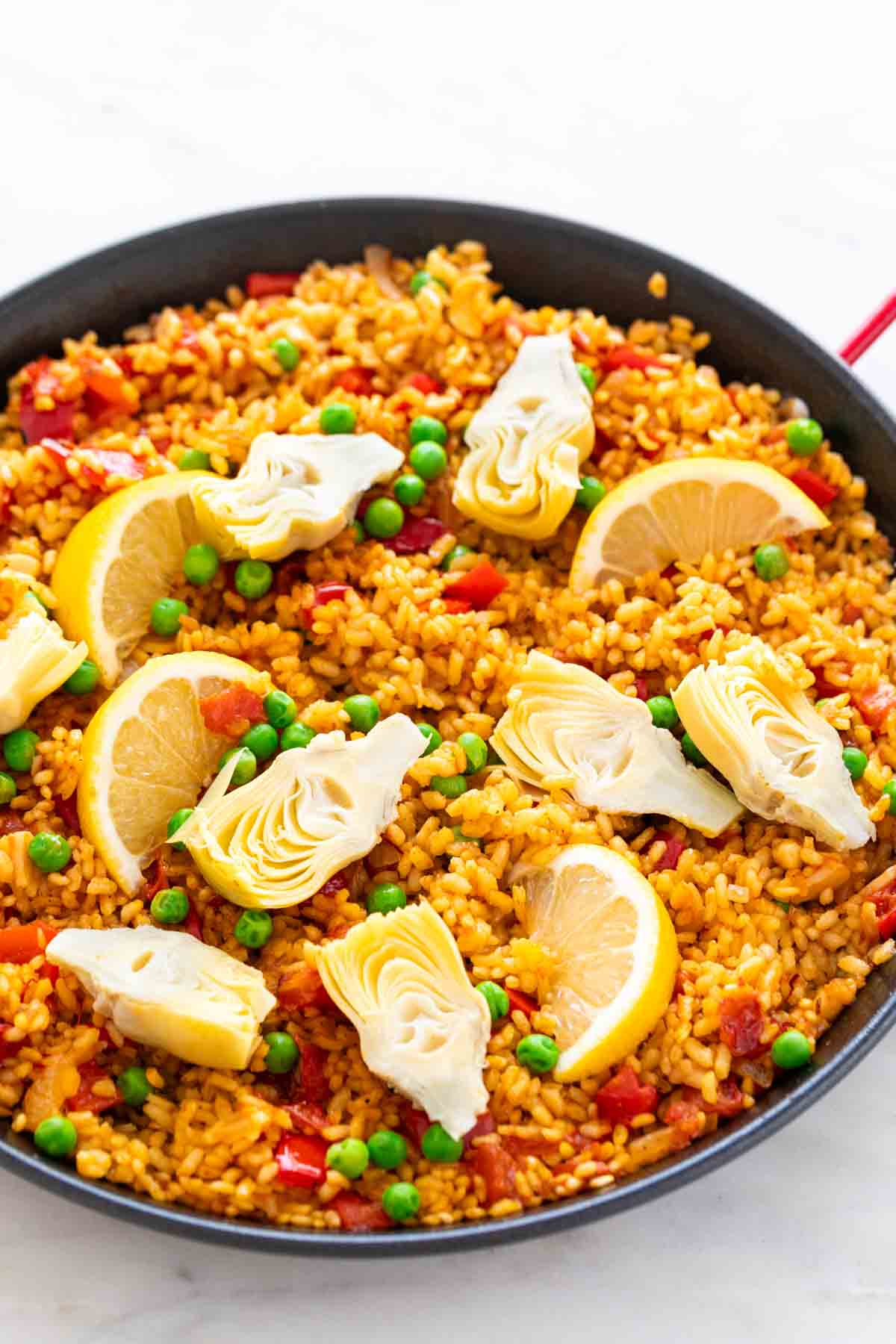
I was born and raised in Spain, so this vegan paella is the real deal. It stays true to traditional flavors while using plant-based ingredients, giving you the best of both worlds.
Whether you’ve made paella before or it’s your first time, this easy recipe will guide you step by step. In no time, you’ll be enjoying a tasty and authentic Spanish meal right at home!
Looking for more delicious Spanish vegan recipes? Try my Gazpacho, Spanish Horchata, and Pan con Tomate (Spanish Tomato Bread) for a true taste of Spain!
Jump to:
🌟 Why you'll love this recipe
- Authentic Spanish Goodness: You’ll get all the real-deal flavors of Spain, but in a totally plant-based version that’s just as delicious.
- Quick and Easy: No need to stress! This vegan paella comes together with easy steps, making it perfect even if you’re short on time.
- Crowd-Pleaser: Everyone’s going to love it! The rich, bold flavors and crispy rice crust make it a dish that’s sure to impress.
- Healthy and Tasty: Packed with fresh veggies and good-for-you ingredients, it’s a meal that’s both nourishing and super satisfying.
- Great for Any Occasion: Whether it’s a weeknight dinner or something special, this vegan paella fits the bill every time.
🧾 Ingredient notes
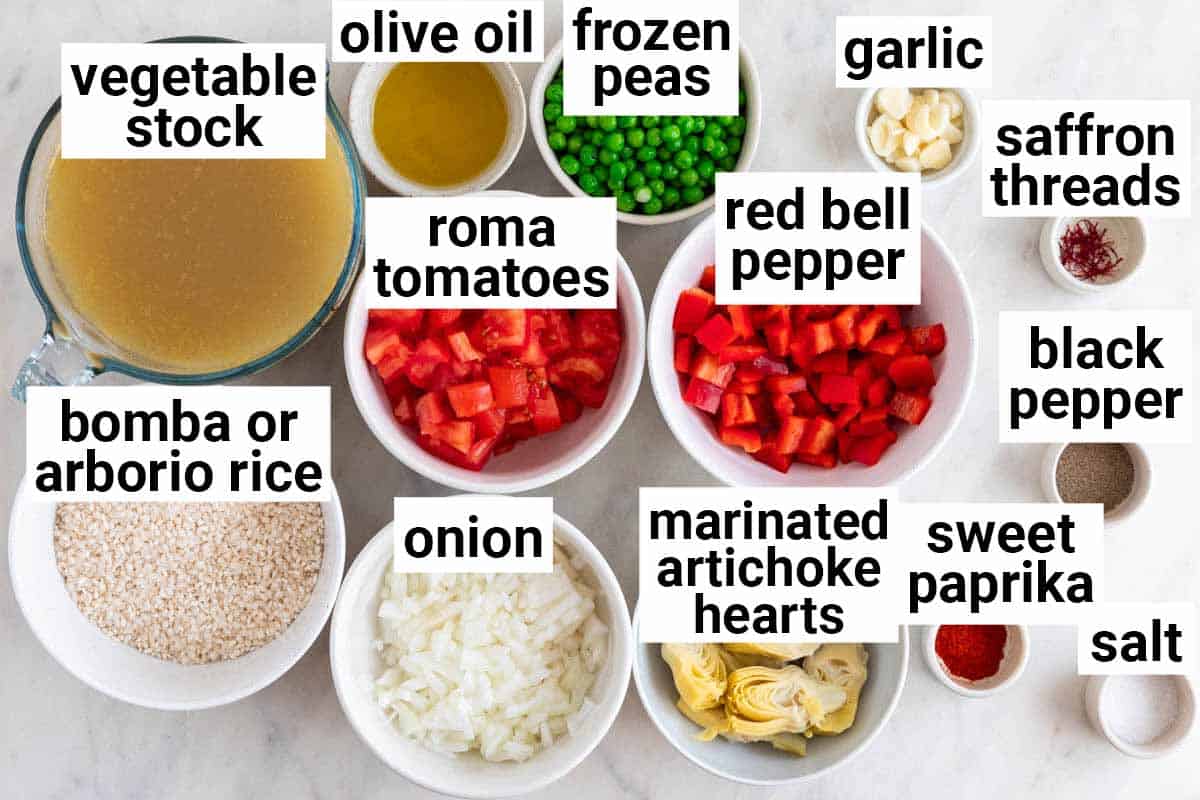
Saffron Threads: Saffron gives paella its bright yellow color and special flavor. You can swap it for ⅛ teaspoon of saffron powder.
If you don’t have any, you can skip it, but the dish won’t be as colorful. Another option is ¼ teaspoon of turmeric for color, though it won’t taste quite the same.
Extra Virgin Olive Oil: This is the go-to oil for cooking in Spain, adding great flavor to your dish.
If you don’t have it, regular olive oil works, or even vegetable or sunflower oil, but the taste won’t be as rich.
Paprika: In Spain, we use Pimentón de la Vera, a smoky paprika with a unique, deep flavor.
If you can find it, use it for the best authentic taste. If not, smoked paprika works, or sweet paprika in a pinch.
Bomba or Arborio Rice: In Spain, we traditionally use Bomba rice for paella because it absorbs liquid without becoming mushy, resulting in firm, separate grains.
If you can’t find Bomba, Arborio rice is a good substitute, as it also absorbs a lot of liquid, though the texture will be a bit creamier.
Veggies: I’ve used garlic, onion, red bell pepper, roma tomatoes, frozen peas, and artichoke hearts in this recipe, but feel free to use whatever veggies you have on hand.
The beauty of paella is that it’s versatile, so you can adapt it with what’s available while still enjoying a flavorful, hearty dish.
See the recipe card below for a full list of ingredients and measurements.
📋 Variations
- Swap the Veggies: Don’t have artichokes or peas? You can easily swap them out for other veggies like zucchini, asparagus, or green beans for a fresh twist.
- Use Brown Rice: For a heartier version, substitute white rice with brown rice. Keep in mind, brown rice may take longer to cook and require more liquid.
- Add Piquillo Peppers: Incorporating piquillo peppers gives a sweet and slightly smoky touch, staying true to authentic Spanish flavors.
- Throw in Mushrooms: For a meatier texture, add mushrooms like button, shiitake, or portobello. They soak up the flavor and add a Spanish touch.
- Add Broad Beans: Toss in fresh, frozen, or canned broad beans with the veggies or cook with the rice for a hearty, traditional flavor.
But please, don’t add vegan chorizo. Paella never has chorizo in Spain, it’s a big no-no!
🔪 Instructions
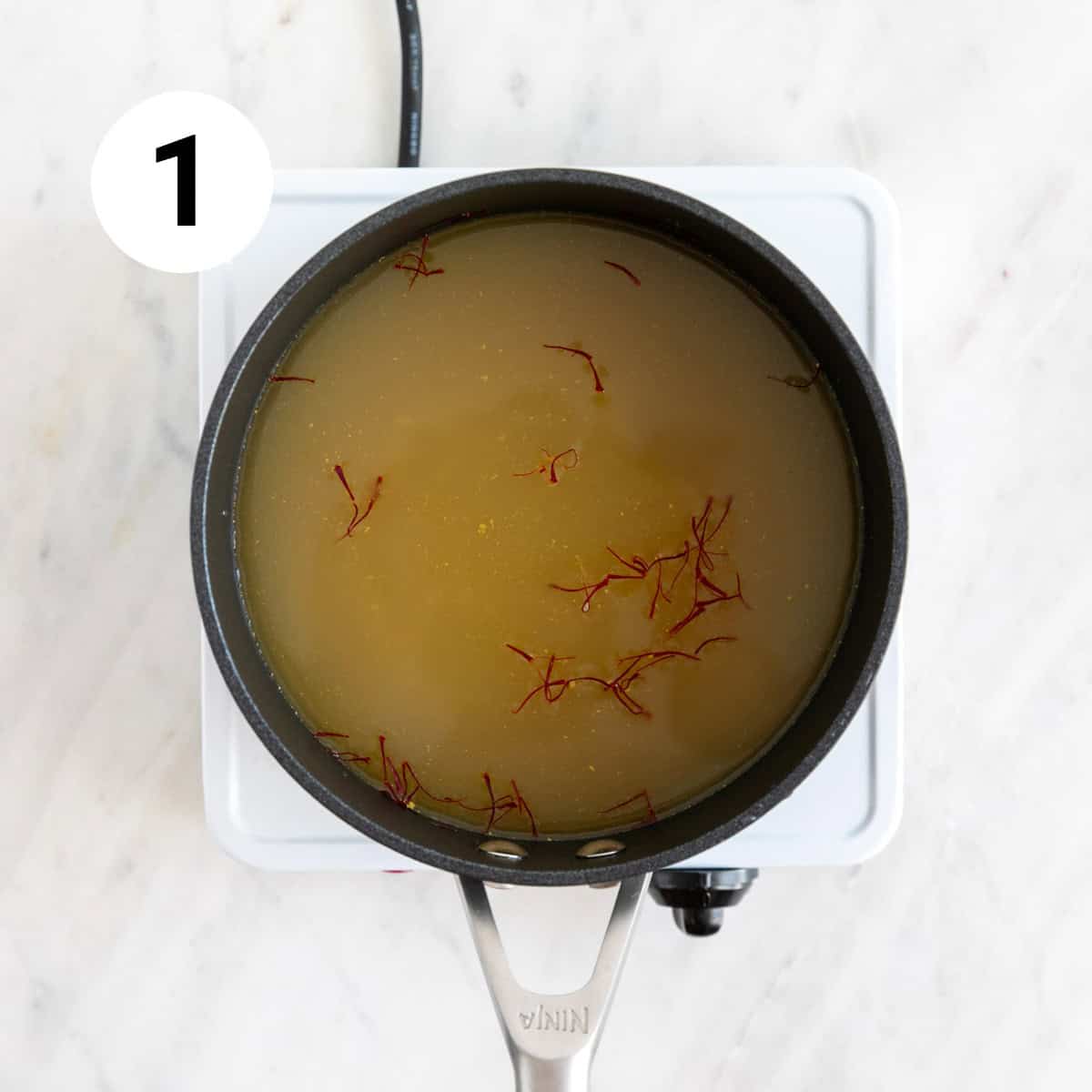
Step 1. Heat the vegetable broth in a medium saucepan over medium-high heat. Break up the saffron and stir it in. Once it simmers, cook for 1 minute, then lower the heat to keep warm.
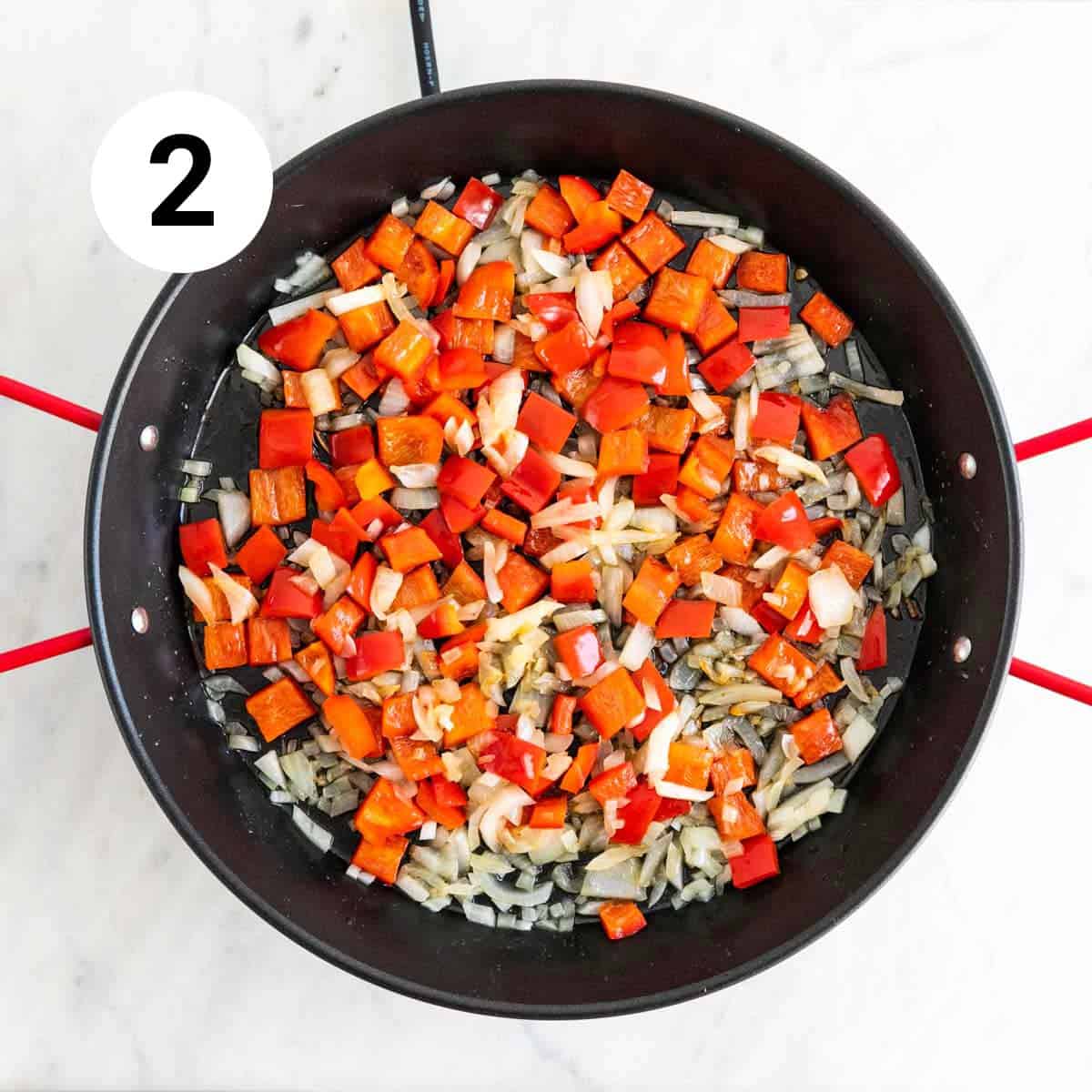
Step 2. Heat the oil in a 12-inch (30 centimeters) paella pan, or something similarly sized (ideally a stainless steel or cast iron skillet), over medium heat. Add the onions and peppers, and sauté until softened and lightly browned, about 3-5 minutes.
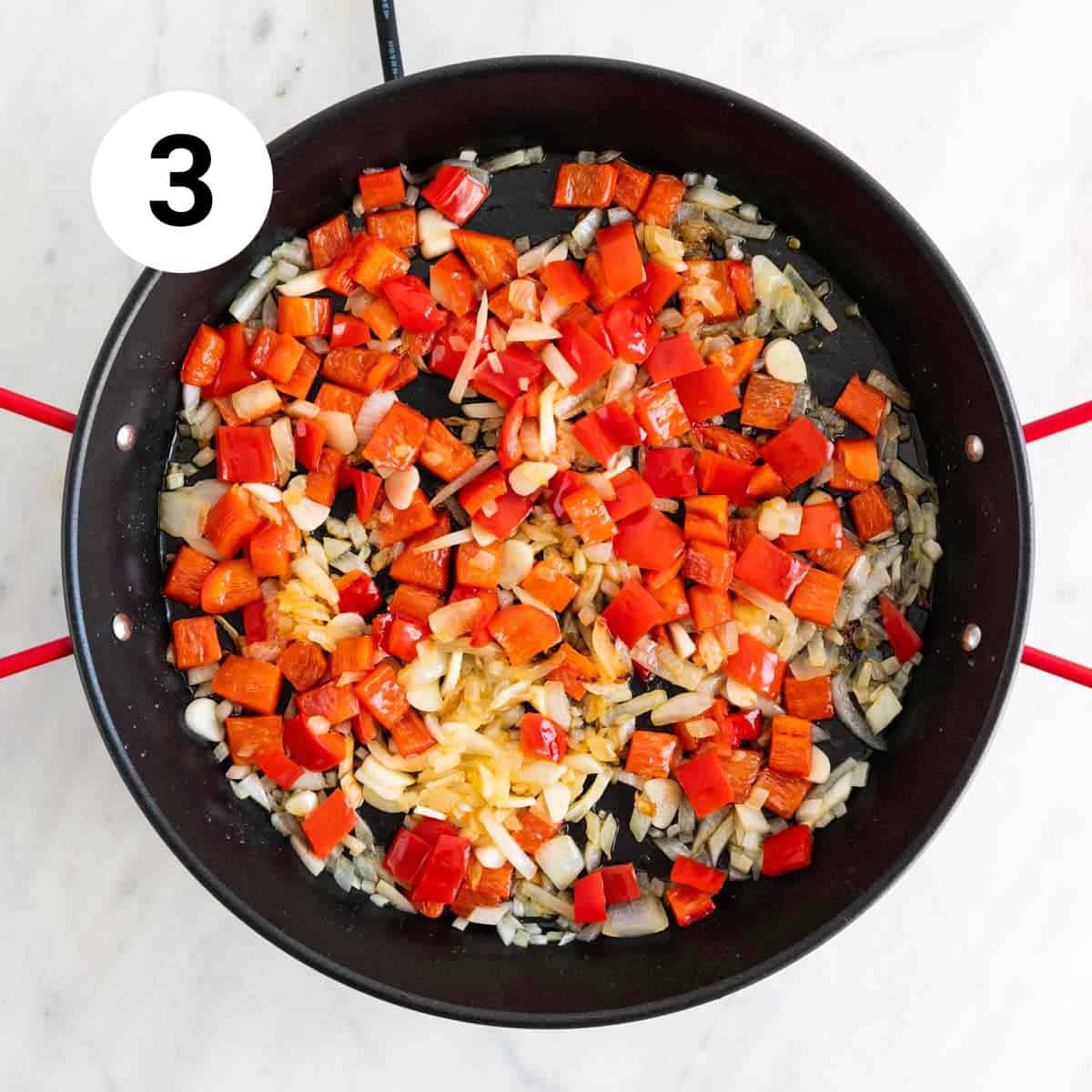
Step 3. Add the garlic and sauté for 1 minute.
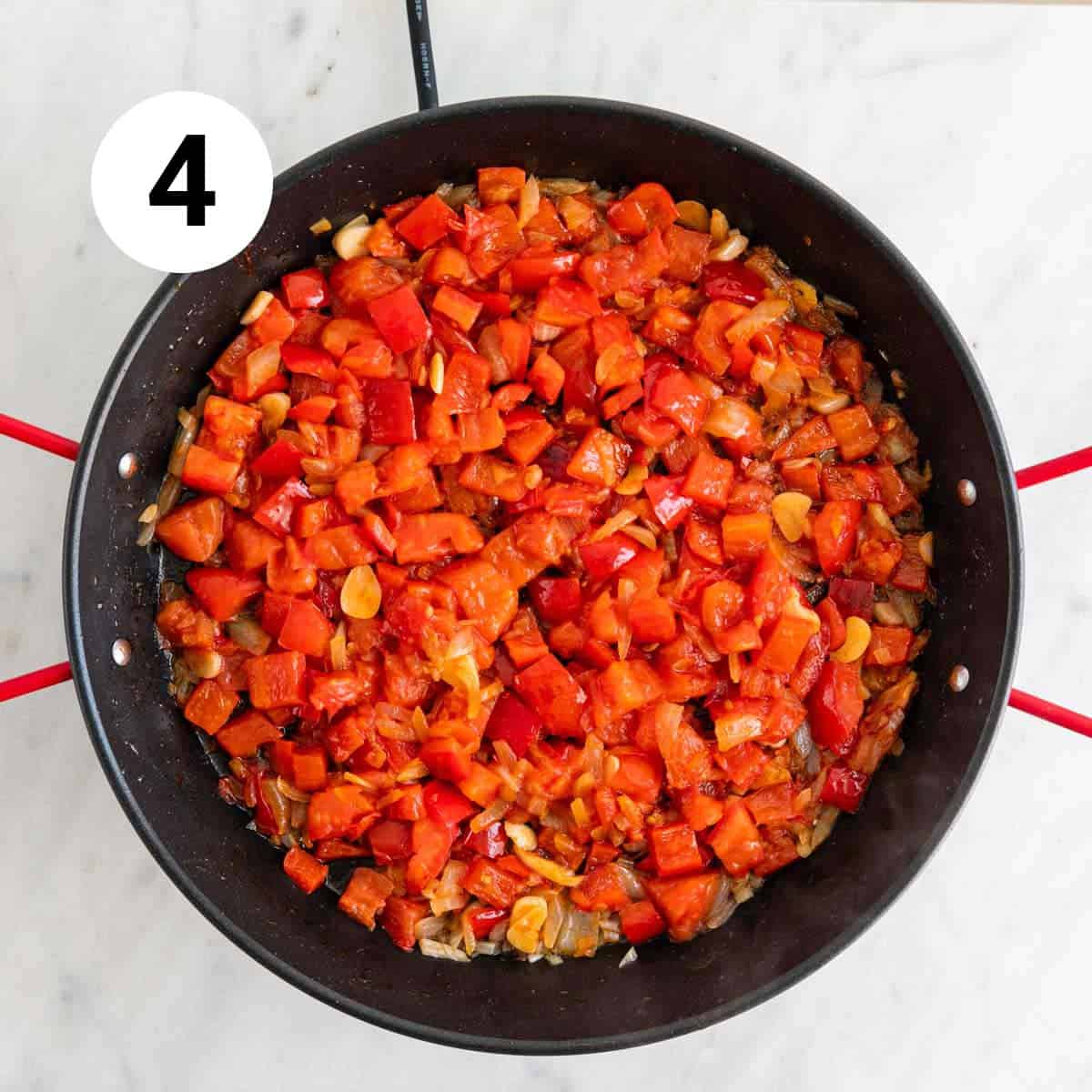
Step 4. Add the tomatoes and paprika, stir, and sauté for about 5-10 minutes.
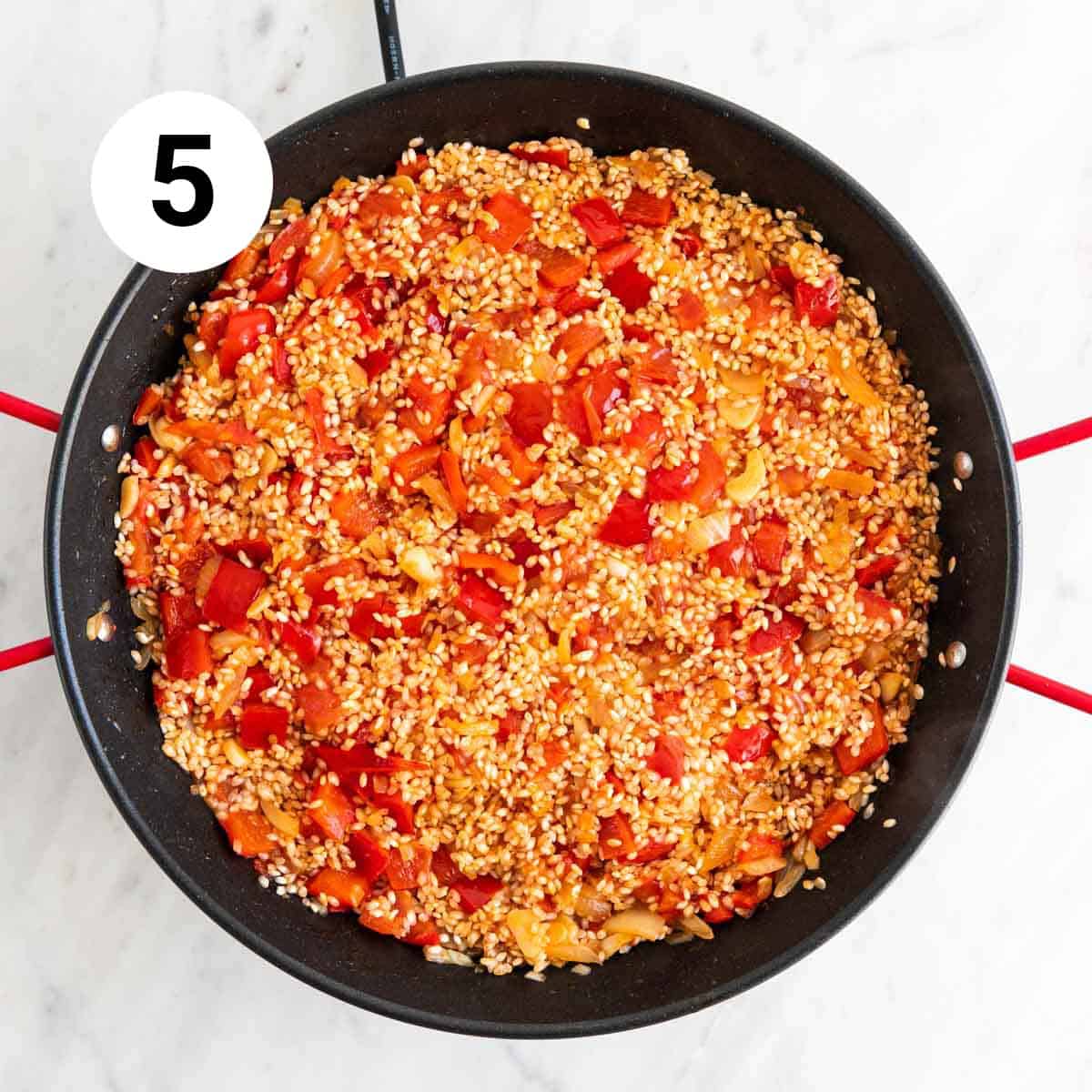
Step 5. Add the rice and stir to coat and lightly toast the grains, about 2 minutes. Make sure the rice is spread in an even layer.
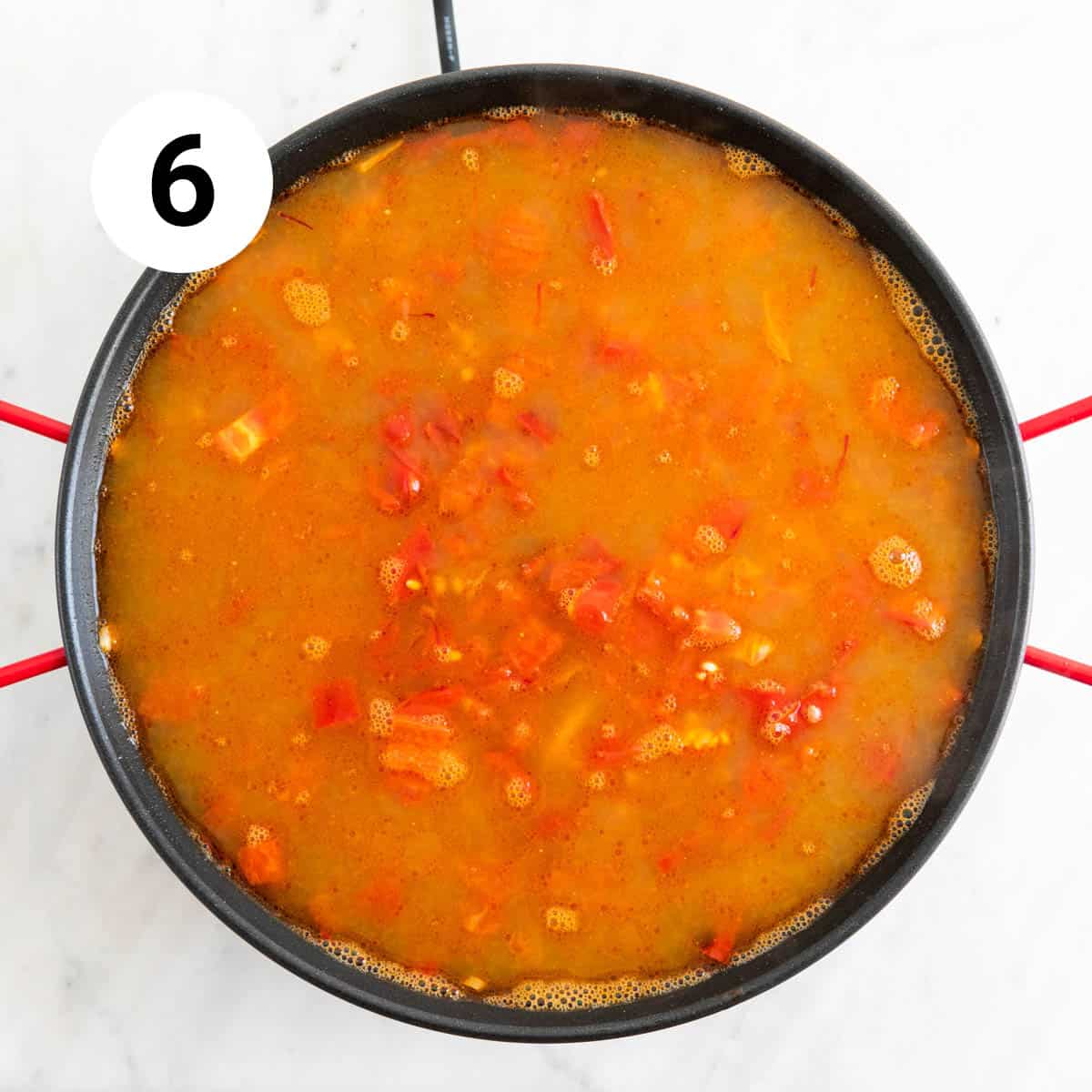
Step 6. Add the vegetable broth.
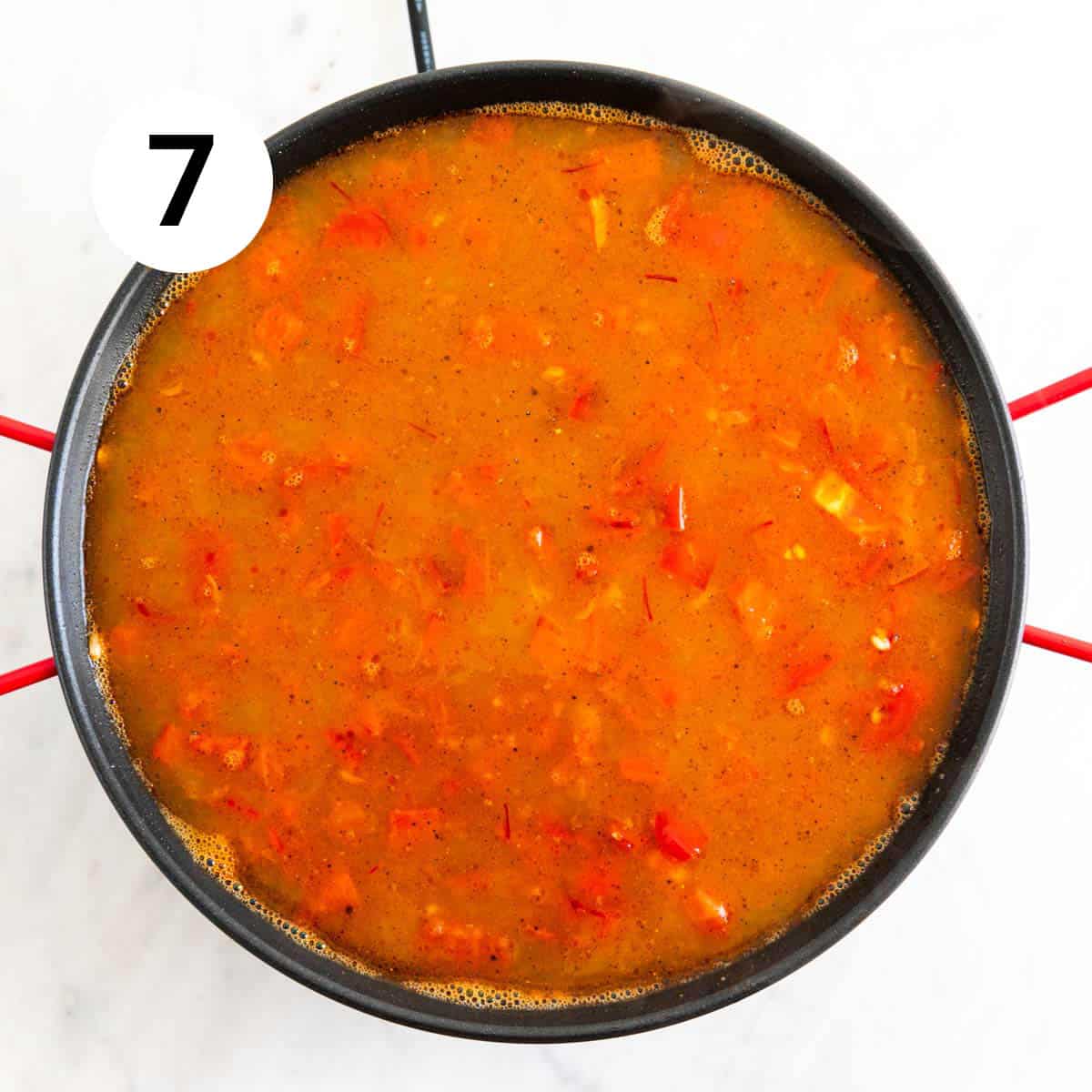
Step 7. Add salt and pepper and, from this point on, avoid stirring to prevent releasing starches that can make the rice creamy. This allows the socarrat (the crispy layer at the bottom) to form properly. Increase the heat to medium-high and bring the broth to a vigorous simmer for 1-2 minutes.
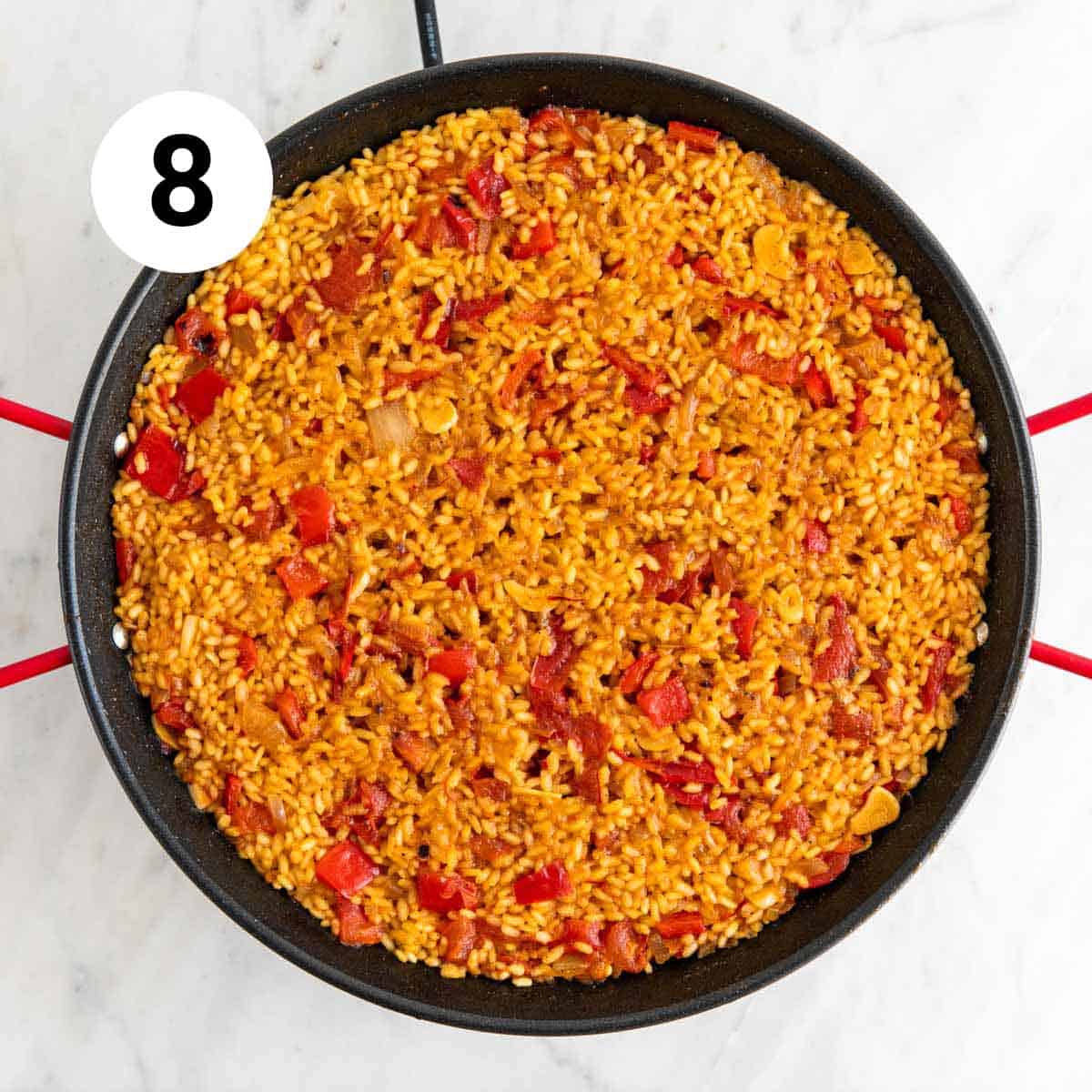
Step 8. Reduce the heat to medium-low and cook uncovered for 15-20 minutes until the rice is al dente. As the broth evaporates, pay attention to the socarrat. You’ll hear a crackling sound and smell a nutty aroma as it develops, which should take about 1-2 minutes. To check, gently stick a fork or spoon into the bottom. If it smells burnt, remove it from the heat immediately. (See notes for more info).
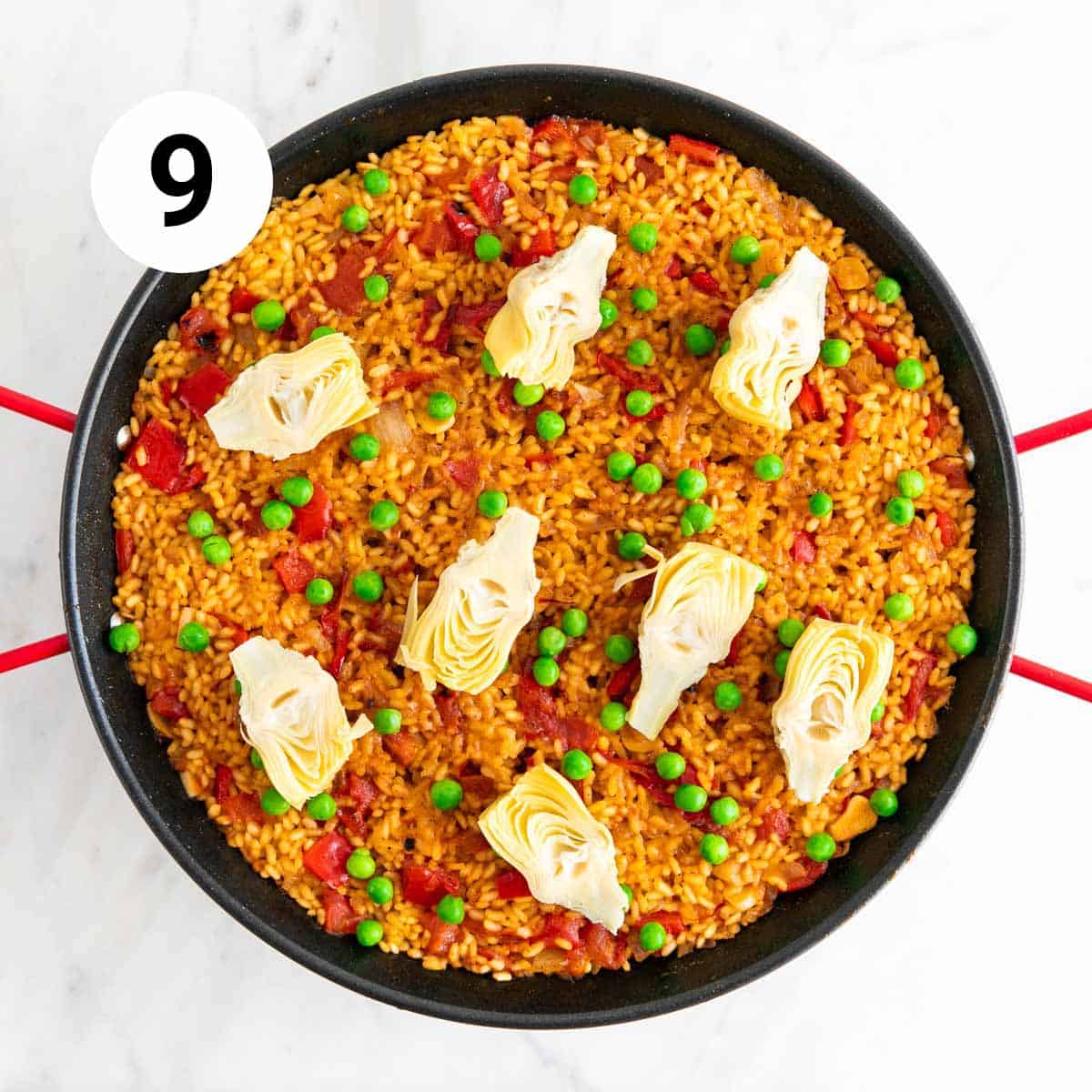
Step 9. Take the pan off the heat. Arrange the artichokes and peas on top of the rice without mixing them in.
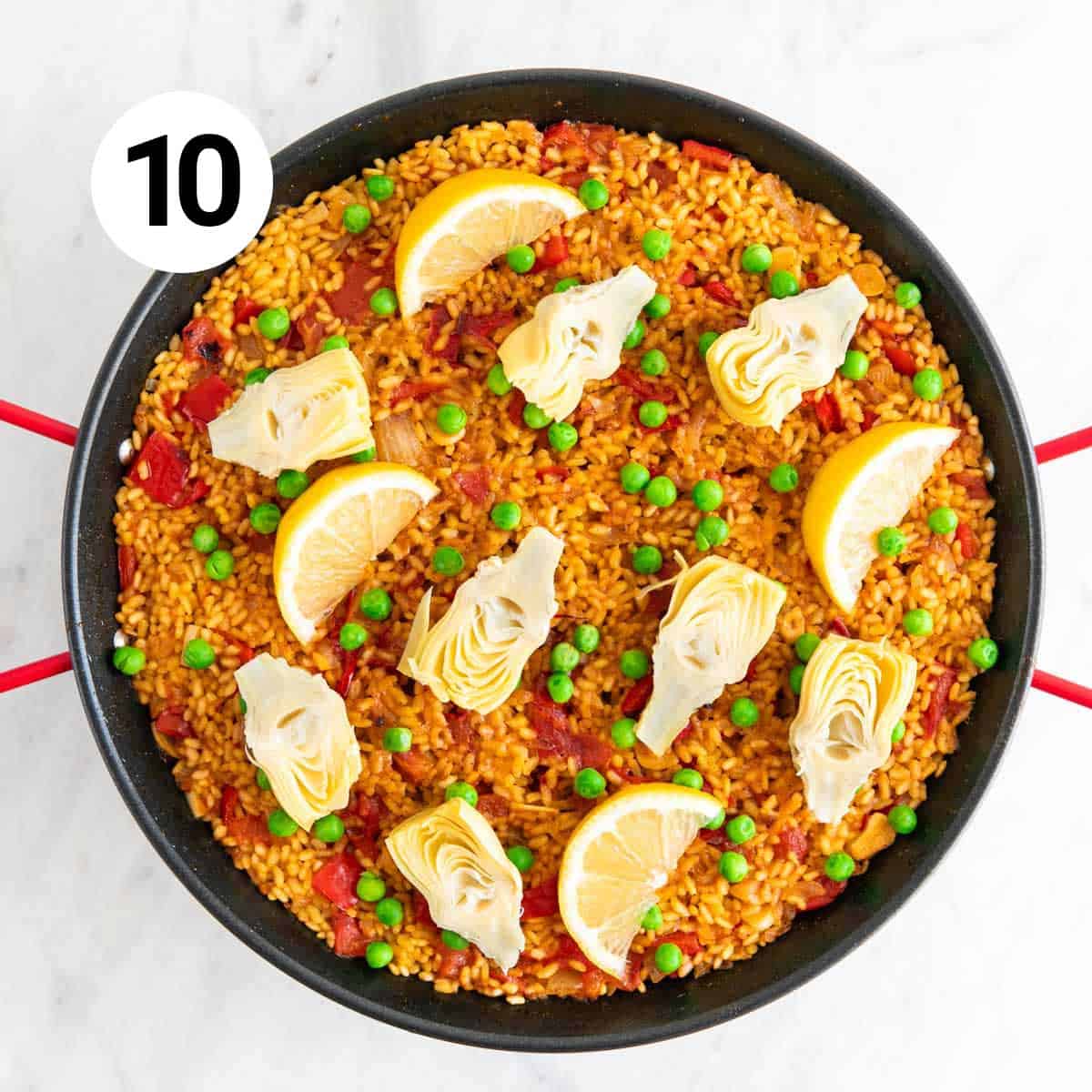
Step 10. Cover the pan with a clean kitchen towel or a lid and let the vegan paella rest for 5 minutes to allow the flavors to meld. Serve with lemon wedges placed on top.
💭 Expert tips
- Cook Uncovered: Always cook the vegan paella uncovered to allow excess liquid to evaporate and achieve the right texture.
- Sauté the Sofrito Well: Take your time to sauté the onions, peppers, and garlic until they’re well-cooked and caramelized. This base is crucial for flavor.
- Add the Broth Gradually: When adding the broth, do it slowly and ensure it’s hot. This helps the rice cook evenly and absorb flavors without shocking the grains.
- Avoid Overcrowding: Don’t overload the pan with ingredients. A single layer of rice is ideal for even cooking and developing the socarrat.
- No Stir During Cooking: To prevent the rice from getting mushy, don’t stir or shake the paella after adding the broth. Just leave it as is!
❓Recipe FAQs
Vegan paella typically lasts about 3 to 5 days in the fridge when stored in an airtight container.
Just make sure to let it cool before placing it in the fridge to maintain the best texture and flavor.
If you're not going to eat it within that time frame, you can also freeze it for longer storage!
Yes, you can freeze vegan paella for later use! Just let it cool completely, then transfer it to an airtight container or freezer-safe bag.
It can last in the freezer for about 2 to 3 months.
When you're ready to eat it, thaw it in the fridge overnight and reheat it on the stove or in the microwave.
Keep in mind that the texture might change slightly after freezing, but it should still taste great!
To reheat vegan paella, you have a couple of options.
Stovetop: Place the paella in a skillet or saucepan over medium heat.
Add a splash of vegetable broth or water to help prevent it from drying out.
Cover the pan with a lid and heat for about 5-10 minutes, stirring occasionally, until it’s heated through.
Microwave: Transfer a portion of the paella to a microwave-safe dish.
Add a little vegetable broth or water to keep it moist, then cover the dish loosely.
Microwave on medium power for 1-2 minutes, stirring halfway through, until it’s heated evenly.
Whichever method you choose, make sure the paella is heated thoroughly before serving!
You don’t have to use a paella pan to make vegan paella.
While it’s traditional and helps with even cooking, you can use any wide, shallow skillet or pan.
Just make sure it has a flat bottom so you can get that crispy socarrat.
It's best to use a stainless steel or cast iron skillet for optimal heat distribution.
Just keep in mind that cooking times might be a little different depending on the pan you choose!
This is the crispy golden crust that forms on the bottom of the pan.
It infuses the paella with a deep smoky and slightly nutty flavor. It's glorious!
Once the broth starts cooking off, that's when the socarrat magic starts to happen.
You'll hear a subtle snap, crackle and popping sound. Plus, you'll smell a toasty aroma that's just heavenly.
If you want to learn more about making paella, check out this post about An Introduction to Spanish Paella. It’s full of great tips!
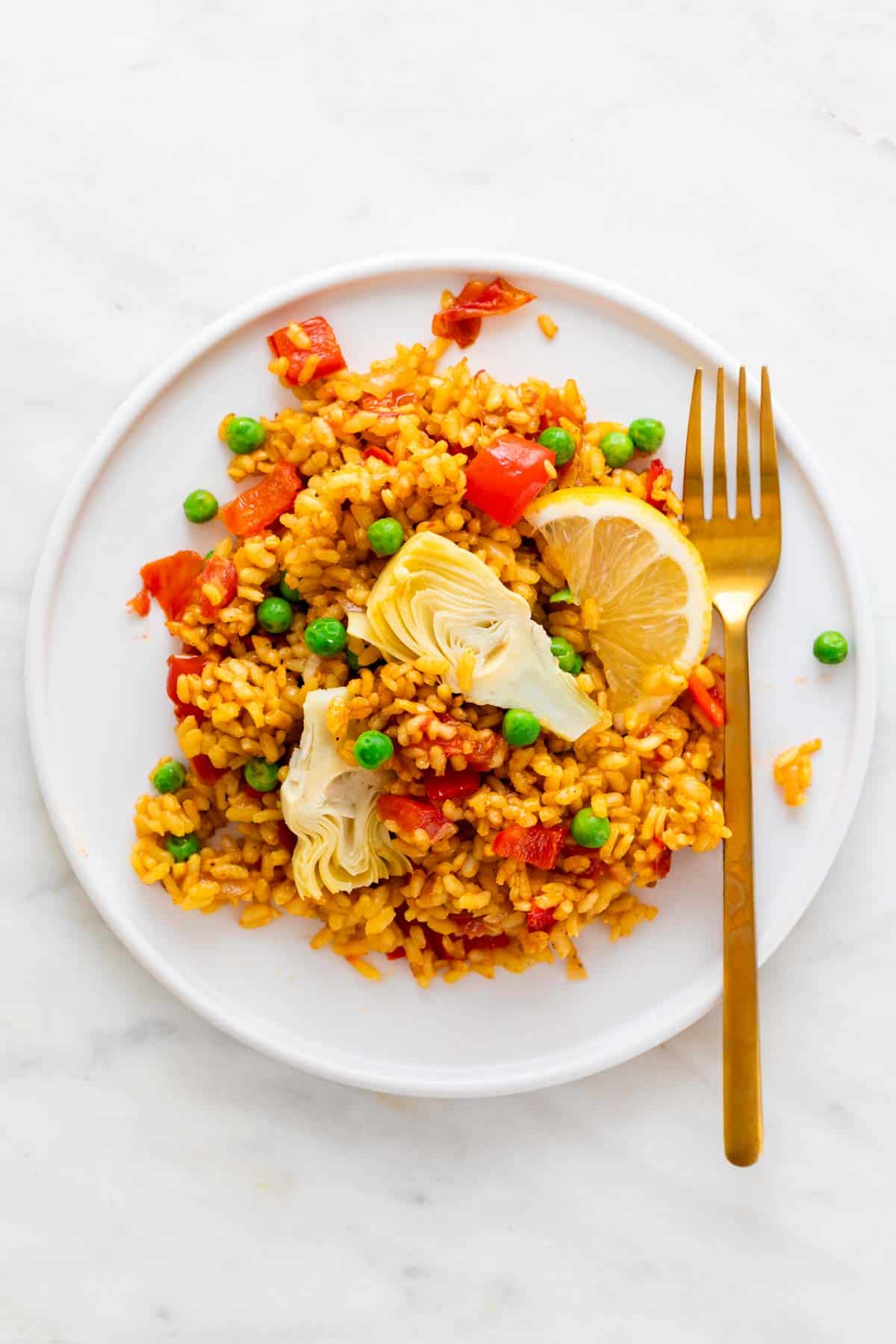
🍚 More delicious vegan rice recipes
Did you like this recipe? Please leave a rating and comment below!
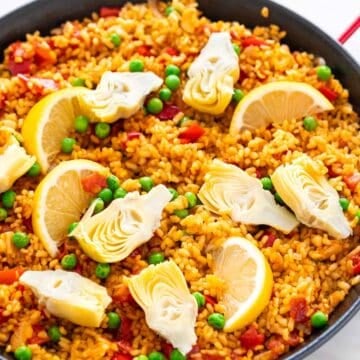
Easy Vegan Paella (Authentic Spanish Recipe)
Ingredients
- 4 cups vegetable broth
- ¼ teaspoon saffron threads, you can also use ⅛ teaspoon of saffron powder, or ¼ teaspoon of turmeric powder
- 3 tablespoons extra virgin olive oil
- 1 medium onion, chopped
- 1 red bell pepper, chopped
- 4 cloves garlic, sliced
- 2 roma tomatoes, diced
- ½ teaspoon paprika, ideally Spanish pimentón de la Vera, but you can also use smoked or sweet paprika
- 1 teaspoon salt
- ½ teaspoon ground black pepper
- 1 and ½ cups bomba or arborio rice
- ¼-½ cup frozen peas, thawed
- 4 marinated artichoke hearts, halved
- 1 lemon, cut into wedges, optional
Instructions
- Heat the vegetable broth in a medium saucepan over medium-high heat. Break up the saffron and stir it in. Once it simmers, cook for 1 minute, then lower the heat to keep warm.
- Heat the oil in a 12-inch (30 centimeters) paella pan, or something similarly sized (ideally a stainless steel or cast iron skillet), over medium heat. Add the onions and peppers, and sauté until softened and lightly browned, about 3-5 minutes.
- Add the garlic and sauté for 1 minute.
- Add the tomatoes and paprika, stir, and sauté for about 5-10 minutes.
- Add the rice and stir to coat and lightly toast the grains, about 2 minutes. Make sure the rice is spread in an even layer.
- Add the vegetable broth.
- Add salt and pepper and, from this point on, avoid stirring to prevent releasing starches that can make the rice creamy. This allows the socarrat (the crispy layer at the bottom) to form properly. Increase the heat to medium-high and bring the broth to a vigorous simmer for 1-2 minutes.
- Reduce the heat to medium-low and cook uncovered for 15-20 minutes until the rice is al dente. As the broth evaporates, pay attention to the socarrat. You’ll hear a crackling sound and smell a nutty aroma as it develops, which should take about 1-2 minutes. To check, gently stick a fork or spoon into the bottom. If it smells burnt, remove it from the heat immediately. (See notes for more info).
- Take the pan off the heat. Arrange the artichokes and peas on top of the rice without mixing them in.
- Cover the pan with a clean kitchen towel or a lid and let the vegan paella rest for 5 minutes to allow the flavors to meld. Serve with lemon wedges placed on top.

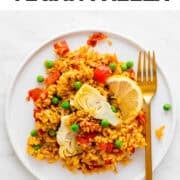


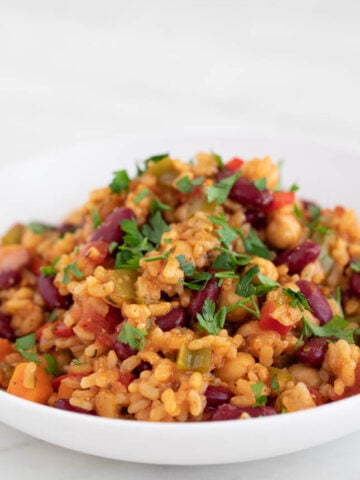
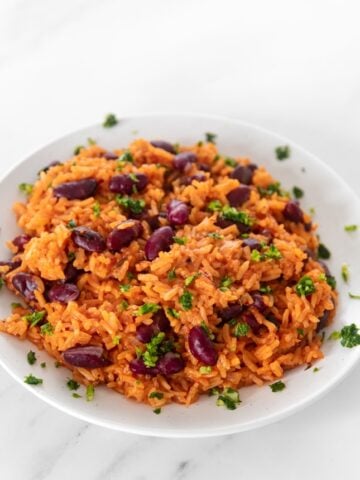
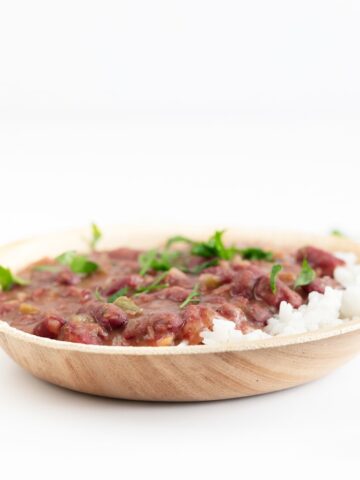
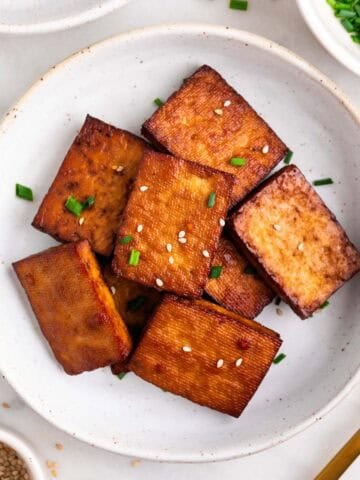

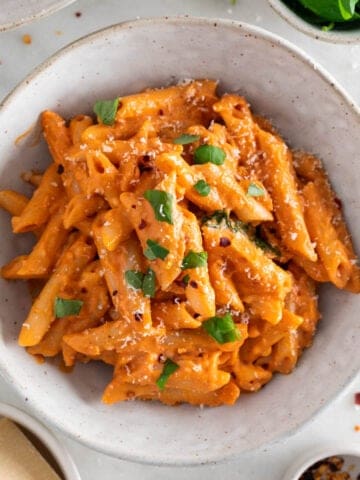
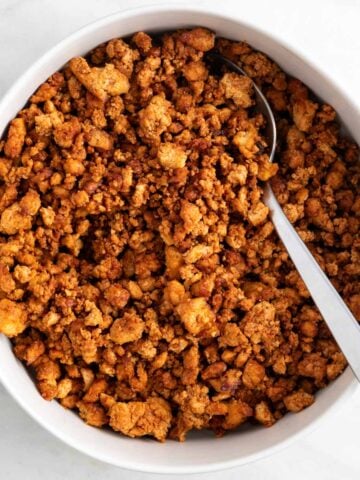
Jackie Thomas says
Hi my husaband and I travelled Spain for 12 weeks, we loved it. I'm a vegetarian and wherever we ate -paella was my go too. Your recipe looks so authentic to what we had, from cadequez, Pamploma, Malaga all over. Thank you for your sharing - I can't wait to try. I just hope I don't burn it! The only bad thing about Spain - it's not a part of our home of Australia. Jackie
Iosune says
Hi Jackie! I was born in Pamplona and I live in Málaga since I was 3 🙂 Thanks a lor for your kind words! Hope you enjoy the recipe!!!!
Seyaa says
Hi Iosune,
I lived in a school in Sagunto in Valencia for 3 weeks when I was 18. Every Sunday we had vegetarian Paella for dinner and as a result I don't like the traditional paella with seafood or chicken. I can't wait to try your recipe because it reminds me of that dish especially when u mention the sliced lemons on top. I'm so excited. Thanks for sharing.
Iosune says
Hi Seyaa! Hope you liked Spain 😉 Enjoy your vegan paella!
Lindsey says
Thank you for this recipe! I loved it and the directions were so easy to follow. I rarely cook rice and it came out perfect. I just adjusted a couple of the vegetables for those I had in my fridge.
Iosune says
Hi Lindsey! You're so welcome 😉 I'm so glad you liked the paella!
Iosune says
Hi Cheryl! I'm Spanish, so I know how to cook Paella. If you read the post, you will see I say Paella is usually made with Bomba rice or short grain rice, but I prefer to use Basmati because it has a lower glycemic index. Have a nice day!!!
Iosune says
Hola Tara! Muchas gracias 🙂 Seguiremos compartiendo recetas españolas, no te preocupes 🙂 Muchas gracias por avisar del bloqueo de Pinterest! Un saludo!
Dylan says
I have found an amazing company to get Veggie bouillon cubes from. Totally natural ingredients and a wonderful flavor. No MSG. https://www.iherb.com/Rapunzel-Vegan-Vegetable-Bouillon-with-Herbs-8-Cubes-3-1-oz-88-g/30387
Iosune says
Hi Dylan! Thanks a lot!!! 🙂
Miriam says
We used quinoa as a substitute for rice--yum!
Iosune says
Hi Miriam! I've never made this recipe using quinoa, but it sounds great!
Rosanna says
I made this recipe last night for my Christmas party and it was a hit!.. I added green olives so I didn't add salt and omitted the peas.. I used snap peas instead of the green beans! Thank you Iosune!
Iosune says
Hi Rosanna! Yayyyy! I'm glad you liked it 😀 Thanks a lot for making the recipe!
Marcus says
This was super delicious!! I followed this recipe today and yesterday I did the Poor man's potatoes that you also have on this site, they are now two of my favourite foods! Thank you very much for posting these awesome recipes 🙂
Iosune says
Hi Marcus! Yay!!!! I'm glad you like the recipes 😀 Thanks a lot!
Stephanie says
Thank you so much for sharing this recipe! My boyfriend and I made the paella for dinner tonight and it was incredible. He kept commenting about how the dish was 'restaurant-quality' and that it was 'one of the best dishes we have ever made.' I am so glad I thought beforehand to increase the recipe, so that I have leftovers. I can't wait to eat the paella again for lunch tomorrow!
Iosune says
Hi Stephanie! I'm so happy you loved the recipe 😀 I really love paella, I eat it almost every week!!!
Angela says
Love your recipes ! Can't wait to make this 🙂 looks delicious!!
Iosune says
Hi Angela! Thank you 😀 I hope you like it!
Juan Carlos Rodriguez says
Thank you very much..... Muchas gracias por esta receta, la hare lo antes posible... y por favor sigan enviando mas recetas Españolas veganas... un beso y abrazo.
Iosune says
Gracias Juan Carlos! Tenemos un blog en español, danzadefogones.com con más recetas 😀 De todas formas seguiremos poniendo recetas españolas por aquí. Un beso!